A Multi-Stage Approach Combining Very High-Resolution Satellite Image, GIS Database and Post-Classification Modification Rules for Habitat Mapping in Hong Kong
Abstract
:1. Introduction
2. Materials and Methods
2.1. Study Area
2.2. Data
2.2.1. WorldView-2 and -3 Satellite Image
2.2.2. Field Survey
2.2.3. Geographic Information System (GIS) Database
2.3. Classification Scheme
2.4. Multi-Stage Mapping Approach
2.5. Stage 1: Initial Image Classification
2.5.1. Variables
2.5.2. Training Data
2.5.3. Classification Algorithms
2.6. Stage 2: Rectification of Misclassified Pixels
2.7. Stage 3: Production of Habitat Map
2.7.1. Generation of Mixed Habitat Classes
2.7.2. Expansion of Habitat Classification
2.7.3. Accuracy Assessment
3. Results
3.1. Classification Maps and Accuracies
3.2. Habitat Map and Accuracies
4. Discussion
4.1. Three-Stage Mapping Procedure
4.2. Selection of Algorithms during Classification Process
4.3. Use of Information Layers and Modification Rules to Enhance Mapping Accuracies and Expand the Classification Scheme
4.4. Soft Classification Method to Identify Mixed Habitats
4.5. Hybrid Approach to Identify Rural Plantation Habitats
5. Conclusions
Supplementary Materials
Author Contributions
Funding
Institutional Review Board Statement
Informed Consent Statement
Data Availability Statement
Acknowledgments
Conflicts of Interest
References
- Bunce, R.G.H.; Bogers, M.M.B.; Evans, D.; Halada, L.; Jongman, R.H.G.; Mucher, C.A.; Bauch, B.; de Blust, G.; Parr, T.W.; Olsvig-Whittaker, L. The significance of habitats as indicators of biodiversity and their links to species. Ecol. Indic. 2013, 33, 19–25. [Google Scholar] [CrossRef]
- Buchanan, G.M.; Brink, A.B.; Leidner, A.K.; Rose, R.; Wegmann, M. Advancing terrestrial conservation through remote sensing. Ecol. Inform. 2015, 30, 318–321. [Google Scholar] [CrossRef]
- Weiers, S.; Bock, M.; Wissen, M.; Rossner, G. Mapping and indicator approaches for the assessment of habitats at different scales using remote sensing and GIS methods. Landsc. Urban Plan 2004, 67, 43–65. [Google Scholar] [CrossRef]
- Pettorelli, N.; Laurance, W.F.; O’Brien, T.G.; Wegmann, M.; Nagendra, H.; Turner, W. Satellite remote sensing for applied ecologists: Opportunities and challenges. J. Appl. Ecol. 2014, 51, 839–848. [Google Scholar] [CrossRef]
- Bell, G.; Neal, S.; Medcalf, K. Use of remote sensing to produce a habitat map of Norfolk. Ecol. Inform. 2015, 30, 293–299. [Google Scholar] [CrossRef]
- Corbane, C.; Lang, S.; Pipkins, K.; Alleaume, S.; Deshayes, M.; García Millán, V.E.; Strasser, T.; Vanden Borre, J.; Toon, S.; Michael, F. Remote sensing for mapping natural habitats and their conservation status–New opportunities and challenges. Int. J. Appl. Earth Obs. 2015, 37, 7–16. [Google Scholar] [CrossRef]
- Mao, D.; Wang, Z.; Du, B.; Li, L.; Tian, Y.; Jia, M.; Zeng, Y.; Song, K.; Jiang, M.; Wang, Y. National wetland mapping in China: A new product resulting from object-based and hierarchical classification of Landsat 8 OLI images. ISPRS J. Photogramm. 2020, 164, 11–25. [Google Scholar] [CrossRef]
- Nagendra, H.; Lucas, R.; Honrado, J.P.; Jongman, R.H.G.; Tarantino, C.; Adamo, M.; Mairota, P. Remote sensing for conservation monitoring: Assessing protected areas, habitat extent, habitat condition, species diversity, and threats. Ecol. Indic. 2013, 33, 45–59. [Google Scholar] [CrossRef]
- Feilhauer, H.; Dahlke, C.; Doktor, D.; Lausch, A.; Schmidtlein, S.; Schulz, G.; Stenzel, S. Mapping the local variability of Natura 2000 habitats with remote sensing. Appl. Veg. Sci. 2014, 17, 765–779. [Google Scholar] [CrossRef]
- Mücher, C.A.; Roupioz, L.; Kramer, H.; Bogers, M.M.B.; Jongman, R.H.G.; Lucas, R.M.; Kosmidou, V.E.; Petrou, Z.; Manakos, I.; Padoa-Schioppa, E.; et al. Synergy of airborne LiDAR and Worldview-2 satellite imagery for land cover and habitat mapping: A BIO_SOS-EODHaM case study for the Netherlands. Int. J. Appl. Earth Obs. 2015, 37, 48–55. [Google Scholar] [CrossRef]
- Räsänen, A.; Virtanen, T. Data and resolution requirements in mapping vegetation in spatially heterogeneous landscapes. Remote Sens. Environ. 2019, 230, 111207. [Google Scholar] [CrossRef]
- Ma, L.; Li, M.; Ma, X.; Cheng, L.; Du, P.; Liu, Y. A review of supervised object-based land-cover image classification. ISPRS J. Photogramm. 2017, 130, 277–293. [Google Scholar] [CrossRef]
- McCarthy, M.J.; Radabaugh, K.R.; Moyer, R.P.; Muller-Karger, F.E. Enabling efficient, large-scale high-spatial resolution wetland mapping using satellites. Remote Sens. Environ. 2018, 208, 189–201. [Google Scholar] [CrossRef]
- McDermid, G.J.; Franklin, S.E.; LeDrew, E.F. Remote sensing for large-area habitat mapping. Prog. Phys. Geog. 2005, 29, 449–474. [Google Scholar] [CrossRef]
- Inglada, J.; Vincent, A.; Arias, M.; Tardy, B.; Morin, D.; Rodes, I. Operational high resolution land cover map production at the country scale using satellite image time series. Remote Sens. 2017, 9, 95. [Google Scholar] [CrossRef] [Green Version]
- Immitzer, M.; Atzberger, C.; Koukal, T. Tree species classification with random forest using very high spatial resolution 8-Band WorldView-2 satellite data. Remote Sens. 2012, 4, 2661–2693. [Google Scholar] [CrossRef] [Green Version]
- Lottering, R.; Mutanga, O.; Peerbhay, K.; Ismail, R. Detecting and mapping Gonipterus scutellatus induced vegetation defoliation using WorldView-2 pan-sharpened image texture combinations and an artificial neural network. J. Appl. Remote Sens. 2019, 13, 014513. [Google Scholar] [CrossRef]
- Sibanda, M.; Mutanga, O.; Rouget, M. Testing the capabilities of the new WorldView-3 space-borne sensor’s red-edge spectral band in discriminating and mapping complex grassland management treatments. Int. J. Remote Sens. 2017, 38, 1–22. [Google Scholar] [CrossRef]
- Adamo, M.; Tomaselli, V.; Tarantino, C.; Vicario, S.; Veronico, G.; Lucas, R.; Blonda, P. Knowledge-based classification of grassland ecosystem based on multi-temporal WorldView-2 data and FAO-LCCS taxonomy. Remote Sens. 2020, 12, 1447. [Google Scholar] [CrossRef]
- Nichol, J.; Wong, M.S. Habitat mapping in rugged terrain Using multispectral Ikonos Images. Photogramm. Eng. Remote Sens. 2008, 74, 1325–1334. [Google Scholar] [CrossRef]
- Abbas, S.; Nichol, J.E.; Fischer, G.A. A 70-year perspective on tropical forest regeneration. Sci. Total Environ. 2016, 544, 544–552. [Google Scholar] [CrossRef] [PubMed]
- Li, Q.; Wong, F.K.K.; Fung, T. Classification of mangrove species using combined WordView-3 and LiDAR data in Mai Po nature reserve, Hong Kong. Remote Sens. 2019, 11, 2114. [Google Scholar] [CrossRef] [Green Version]
- Wan, L.; Lin, Y.; Zhang, H.; Wang, F.; Liu, M.; Lin, H. GF-5 hyperspectral data for species mapping of mangrove in Mai Po, Hong Kong. Remote Sens. 2020, 12, 656. [Google Scholar] [CrossRef] [Green Version]
- Erdős, L.; Kröel-Dulay, G.; Bátori, Z.; Kovács, B.; Németh, C.; Kiss, P.J.; Tölgyesi, C. Habitat heterogeneity as a key to high conservation value in forest-grassland mosaics. Biol. Conserv. 2018, 226, 72–80. [Google Scholar] [CrossRef] [Green Version]
- Maxwell, A.E.; Warner, T.A.; Fang, F. Implementation of machine-learning classification in remote sensing: An applied review. Int. J. Remote Sens. 2018, 39, 2784–2817. [Google Scholar] [CrossRef] [Green Version]
- Talukdar, S.; Singha, P.; Mahato, S.; Shahfahad; Pal, S.; Liou, Y.-A.; Rahman, A. Land-use land-cover classification by machine learning classifiers for satellite observations—A review. Remote Sens. 2020, 12, 1135. [Google Scholar] [CrossRef] [Green Version]
- Huang, C.; Davis, L.S.; Townshend, J.R.G. An assessment of support vector machines for land cover classification. Int. J. Remote Sens. 2002, 23, 725–749. [Google Scholar] [CrossRef]
- Breiman, L. Random Forests. Mach. Learn. 2001, 45, 5–32. [Google Scholar] [CrossRef] [Green Version]
- Pouteau, R.; Meyer, J.-Y.; Taputuarai, R.; Stoll, B. Support vector machines to map rare and endangered native plants in Pacific islands forests. Ecol. Inform. 2012, 9, 37–46. [Google Scholar] [CrossRef]
- Sabat-Tomala, A.; Raczko, E.; Zagajewski, B. Comparison of support vector machine and random forest algorithms for invasive and expansive species classification using airborne hyperspectral data. Remote Sens. 2020, 12, 516. [Google Scholar] [CrossRef] [Green Version]
- Whiteside, T.G.; Boggs, G.S.; Maier, S.W. Comparing object-based and pixel-based classifications for mapping savannas. Int. J. Appl. Earth Obs. 2011, 13, 884–893. [Google Scholar] [CrossRef]
- Lawrence, R.L.; Moran, C.J. The AmericaView classification methods accuracy comparison project: A rigorous approach for model selection. Remote Sens. Environ. 2015, 170, 115–120. [Google Scholar] [CrossRef]
- Schmidt, M.A.R.; Bressiani, J.X.; Dos Reis, P.A.; Salla, M.R. Evaluation of the performance of image classification methods in the identification of vegetation. J. Urban Environ. Eng. 2016, 10, 62–71. [Google Scholar] [CrossRef]
- Lu, D.; Weng, Q. A survey of image classification methods and techniques for improving classification performance. Int. J. Remote Sens. 2007, 28, 823–870. [Google Scholar] [CrossRef]
- Khatami, R.; Mountrakis, G.; Stehman, S.V. A meta-analysis of remote sensing research on supervised pixel-based land-cover image classification processes: General guidelines for practitioners and future research. Remote Sens. Environ. 2016, 177, 89–100. [Google Scholar] [CrossRef] [Green Version]
- San Miguel-Ayanz, J.; Biging, G.S. Comparison of single-stage and multi-stage classification approaches for cover type mapping with TM and SPOT data. Remote Sens. Environ. 1997, 59, 92–104. [Google Scholar] [CrossRef]
- Abou El-Magd, I.; Tanton, T.W. Improvements in land use mapping for irrigated agriculture from satellite sensor data using a multi-stage maximum likelihood classification. Int. J. Remote Sens. 2003, 24, 4197–4206. [Google Scholar] [CrossRef]
- Dibs, H.; Idrees, M.O.; Alsalhin, G.B.A. Hierarchical classification approach for mapping rubber tree growth using per-pixel and object-oriented classifiers with SPOT-5 imagery. Egypt. J. Remote. Sens. Space Sci. 2017, 20, 21–30. [Google Scholar] [CrossRef]
- Manandhar, R.; Odeh, I.O.A.; Ancev, T. Improving the accuracy of land use and land cover classification of Landsat data using post-classification enhancement. Remote Sens. 2009, 1, 330–344. [Google Scholar] [CrossRef] [Green Version]
- Thakkar, A.K.; Desai, V.R.; Patel, A.; Potdar, M.B. Post-classification corrections in improving the classification of Land Use/Land Cover of arid region using RS and GIS: The case of Arjuni watershed, Gujarat, India. Egypt. J. Remote Sens. Space Sci. 2017, 20, 79–89. [Google Scholar] [CrossRef] [Green Version]
- Van De Voorde, T.; De Genst, W.; Canters, F. Improving pixel-based VHR land-cover classifications of urban areas with post-classification techniques. Photogramm. Eng. Remote Sens. 2007, 73, 1017–1027. [Google Scholar]
- Rozenstein, O.; Karnieli, A. Comparison of methods for land-use classification incorporating remote sensing and GIS inputs. Appl. Geogr. 2011, 31, 533–544. [Google Scholar] [CrossRef]
- Rapinel, S.; Clément, B.; Magnanon, S.; Sellin, V.; Hubert-Moy, L. Identification and mapping of natural vegetation on a coastal site using a Worldview-2 satellite image. J. Environ. Manage 2014, 144, 236–246. [Google Scholar] [CrossRef] [PubMed] [Green Version]
- Kosmidou, V.; Petrou, Z.; Bunce, R.G.H.; Mücher, C.A.; Jongman, R.H.G.; Bogers, M.M.B.; Lucas, R.M.; Tomaselli, V.; Blonda, P.; Padoa-Schioppa, E.; et al. Harmonization of the Land Cover Classification System (LCCS) with the General Habitat Categories (GHC) classification system. Ecol. Indic. 2014, 36, 290–300. [Google Scholar] [CrossRef] [Green Version]
- Adamo, M.; Tarantino, C.; Tomaselli, V.; Kosmidou, V.; Petrou, Z.; Manakos, I.; Lucas, R.M.; Mücher, C.A.; Veronico, G.; Marangi, C.; et al. Expert knowledge for translating land cover/use maps to General Habitat Categories (GHC). Landsc. Ecol. 2014, 29, 1045–1067. [Google Scholar] [CrossRef] [Green Version]
- Thoonen, G.; Spanhove, T.; Vanden Borre, J.; Scheunders, P. Classification of heathland vegetation in a hierarchical contextual framework. Int. J. Remote Sens. 2013, 34, 96–111. [Google Scholar] [CrossRef]
- Dudgeon, D.; Corlett, R. The Ecology and Biodiversity of Hong Kong, Revised Edition; Lion Nature Education Foundation: Hong Kong, China, 2011. [Google Scholar]
- Environmental Bureau. Hong Kong Biodiversity Strategy and Action Plan 2016–2021; The Government of the Hong Kong Special Administrative Region: Hong Kong, China, 2016. [Google Scholar]
- Corlett, R.T. Environmental forestry in Hong Kong: 1871–1997. For. Ecol. Manag. 1999, 116, 93–105. [Google Scholar] [CrossRef]
- Balthazar, V.; Vanacker, V.; Lambin, E.F. Evaluation and parameterization of ATCOR3 topographic correction method for forest cover mapping in mountain areas. Int. J. Appl. Earth Obs. 2012, 18, 436–450. [Google Scholar] [CrossRef]
- Planning Department of Hong Kong Government. Land Utilization in Hong Kong. Available online: https://www.pland.gov.hk/pland_en/info_serv/open_data/landu/index.html (accessed on 18 October 2021).
- McCoy, R.M. Field Methods in Remote Sensing; Guilford Press: New York, NY, USA, 2005. [Google Scholar]
- Lai, A.C.S.; So, A.C.T.; Ng, S.K.C.; Jonas, D. The territory-wide airborne light detection and ranging survey for the Hong Kong Special Administrative Region. In Proceedings of the 33rd Asian Conference on Remote Sensing, Pattaya, Thailand, 26–30 November 2012; pp. 1682–1690. [Google Scholar]
- Lands Department of Hong Kong Government. Digital Topographic Map. Available online: https://www.landsd.gov.hk/en/survey-mapping/mapping/multi-scale-topographic-mapping/digital-map.html (accessed on 18 October 2021).
- Ashworth, J.M.; Corlett, R.T.; Dudgeon, D.; Melville, D.S.; Tang, W.S.M. Hong Kong Flora and Fauna: Computing Conservation; World Wide Fund for Nature Hong Kong: Hong Kong, 1993. [Google Scholar]
- Environmental Resources Management. 2008 Update of Terrestrial Habitat Mapping and Ranking Based on Conservation Value; Final Report to Sustainable Development Division, Hong Kong Special Administrative Region Government: Hong Kong, China, 2010. [Google Scholar]
- Grizonnet, M.; Michel, J.; Poughon, V.; Inglada, J.; Savinaud, M.; Cresson, R. Orfeo ToolBox: Open source processing of remote sensing images. Open Geospat. Data Softw. Stand. 2017, 2, 15. [Google Scholar] [CrossRef] [Green Version]
- Duro, D.C.; Franklin, S.E.; Dubé, M.G. A comparison of pixel-based and object-based image analysis with selected machine learning algorithms for the classification of agricultural landscapes using SPOT-5 HRG imagery. Remote Sens. Environ. 2012, 118, 259–272. [Google Scholar] [CrossRef]
- Zhu, Y.; Liu, K.; Liu, L.; Myint, S.W.; Wang, S.; Liu, H.; He, Z. Exploring the potential of WorldView-2 red-edge band-based vegetation indices for estimation of mangrove leaf area index with machine learning algorithms. Remote Sens. 2017, 9, 1060. [Google Scholar] [CrossRef] [Green Version]
- Solano, F.; Di Fazio, S.; Modica, G. A methodology based on GEOBIA and WorldView-3 imagery to derive vegetation indices at tree crown detail in olive orchards. Int. J. Appl. Earth Obs. 2019, 83, 101912. [Google Scholar] [CrossRef]
- Xue, J.; Su, B. Significant remote sensing vegetation indices: A review of developments and applications. J. Sens. 2017, 2017, 1353691. [Google Scholar] [CrossRef] [Green Version]
- Huete, A.; Didan, K.; Miura, T.; Rodriguez, E.P.; Gao, X.; Ferreira, L.G. Overview of the radiometric and biophysical performance of the MODIS vegetation indices. Remote Sens. Environ. 2002, 83, 195–213. [Google Scholar] [CrossRef]
- Gitelson, A.A.; Merzlyak, M.N. Remote sensing of chlorophyll concentration in higher plant leaves. Adv. Space Res. 1998, 22, 689–692. [Google Scholar] [CrossRef]
- Daughtry, C.S.T.; Walthall, C.L.; Kim, M.S.; de Colstoun, E.B.; McMurtrey, J.E. Estimating corn leaf chlorophyll concentration from leaf and canopy reflectance. Remote Sens. Environ. 2000, 74, 229–239. [Google Scholar] [CrossRef]
- Kupidura, P. The comparison of different methods of texture analysis for their efficacy for land use classification in satellite imagery. Remote Sens. 2019, 11, 1233. [Google Scholar] [CrossRef] [Green Version]
- Zhou, J.; Yan Guo, R.; Sun, M.; Di, T.T.; Wang, S.; Zhai, J.; Zhao, Z. The Effects of GLCM parameters on LAI estimation using texture values from Quickbird Satellite Imagery. Sci. Rep. 2017, 7, 7366. [Google Scholar] [CrossRef]
- Oksanen, T. Shape-describing indices for agricultural field plots and their relationship to operational efficiency. Comput. Electron. Agr. 2013, 98, 252–259. [Google Scholar] [CrossRef]
- R Core Team. R. A Language and Environment for Statistical Computing, 3.6.3; R Foundation for Statistical Computing: Vienna, Austria, 2020. [Google Scholar]
- Feng, Q.; Liu, J.; Gong, J. UAV remote sensing for urban vegetation mapping using random forest and texture analysis. Remote Sens. 2015, 7, 1074–1094. [Google Scholar] [CrossRef] [Green Version]
- Fisher, P.; Arnot, C.; Wadsworth, R.; Wellens, J. Detecting change in vague interpretations of landscapes. Ecol. Inform. 2006, 1, 163–178. [Google Scholar] [CrossRef]
- Loosvelt, L.; Peters, J.; Skriver, H.; Lievens, H.; Van Coillie, F.M.B.; De Baets, B.; Verhoest, N.E.C. Random Forests as a tool for estimating uncertainty at pixel-level in SAR image classification. Int. J. Appl. Earth Obs. 2012, 19, 173–184. [Google Scholar] [CrossRef]
- Yang, Z.; D’Alpaos, A.; Marani, M.; Silvestri, S. Assessing the fractional abundance of highly mixed salt-marsh vegetation using random forest soft classification. Remote Sens. 2020, 12, 3224. [Google Scholar] [CrossRef]
- Phillips, S.J.; Dudík, M.; Elith, J.; Graham, C.H.; Lehmann, A.; Leathwick, J.; Ferrier, S. Sample selection bias and presence-only distribution models: Implications for background and pseudo-absence data. Ecol. Appl. 2009, 19, 181–197. [Google Scholar] [CrossRef] [PubMed] [Green Version]
- Foody, G.M. Thematic map comparison: Evaluating the statistical significance of differences in classification accuracy. Photogramm. Eng. Remote Sens. 2004, 70, 627–633. [Google Scholar] [CrossRef]
- Congalton, R.G. A review of assessing the accuracy of classifications of remotely sensed data. Remote Sens. Environ. 1991, 37, 35–46. [Google Scholar] [CrossRef]
- Olofsson, P.; Foody, G.M.; Stehman, S.V.; Woodcock, C.E. Making better use of accuracy data in land change studies: Estimating accuracy and area and quantifying uncertainty using stratified estimation. Remote Sens. Environ. 2013, 129, 122–131. [Google Scholar] [CrossRef]
- Olofsson, P.; Foody, G.M.; Herold, M.; Stehman, S.V.; Woodcock, C.E.; Wulder, M.A. Good practices for estimating area and assessing accuracy of land change. Remote Sens. Environ. 2014, 148, 42–57. [Google Scholar] [CrossRef]
- Bradter, U.; O’Connell, J.; Kunin, W.E.; Boffey, C.W.H.; Ellis, R.J.; Benton, T.G. Classifying grass-dominated habitats from remotely sensed data: The influence of spectral resolution, acquisition time and the vegetation classification system on accuracy and thematic resolution. Sci. Total Environ. 2020, 711, 134584. [Google Scholar] [CrossRef] [PubMed]
- Jiao, L.; Sun, W.; Yang, G.; Ren, G.; Liu, Y. A hierarchical classification framework of satellite multispectral/hyperspectral images for mapping coastal wetlands. Remote Sens. 2019, 11, 2238. [Google Scholar] [CrossRef] [Green Version]
- Ghosh, A.; Joshi, P.K. A comparison of selected classification algorithms for mapping bamboo patches in lower Gangetic plains using very high resolution WorldView 2 imagery. Int. J. Appl. Earth Obs. 2014, 26, 298–311. [Google Scholar] [CrossRef]
- Myint, S.W.; Gober, P.; Brazel, A.; Grossman-Clarke, S.; Weng, Q. Per-pixel vs. object-based classification of urban land cover extraction using high spatial resolution imagery. Remote Sens. Environ. 2011, 115, 1145–1161. [Google Scholar] [CrossRef]
- Wood, E.M.; Pidgeon, A.M.; Radeloff, V.C.; Keuler, N.S. Image texture as a remotely sensed measure of vegetation structure. Remote Sens. Environ. 2012, 121, 516–526. [Google Scholar] [CrossRef]
- Du, P.; Xia, J.; Zhang, W.; Tan, K.; Liu, Y.; Liu, S. Multiple classifier system for remote sensing image classification: A review. Sensors 2012, 12, 4764–4792. [Google Scholar] [CrossRef]
- Buck, O.; Millán, V.E.G.; Klink, A.; Pakzad, K. Using information layers for mapping grassland habitat distribution at local to regional scales. Int. J. Appl. Earth Obs. 2015, 37, 83–89. [Google Scholar] [CrossRef]
- Harris, P.M.; Ventura, S.J. The integration of geographic data with remotely sensed imagery to improve classification in an urban area. Photogramm. Eng. Remote Sens. 1995, 61, 993–998. [Google Scholar]
- Sulla-Menashe, D.; Gray, J.M.; Abercrombie, S.P.; Friedl, M.A. Hierarchical mapping of annual global land cover 2001 to present: The MODIS Collection 6 Land Cover product. Remote Sens. Environ. 2019, 222, 183–194. [Google Scholar] [CrossRef]
- Somay, L.; Szigeti, V.; Boros, G.; Ádám, R.; Báldi, A. Wood pastures: A transitional habitat between forests and pastures for dung beetle assemblages. Forests 2021, 12, 25. [Google Scholar] [CrossRef]
- Shea, M.E.; Clayton, M.K.; Townsend, P.A.; Berg, S.; Elza, H.; Mladenoff, D.J. Identifying ecotone location using the co-occurrence property. J. Veg. Sci. 2021, 32, e12929. [Google Scholar] [CrossRef]
- Jung, M.; Dahal, P.R.; Butchart, S.H.M.; Donald, P.F.; De Lamo, X.; Lesiv, M.; Kapos, V.; Rondinini, C.; Visconti, P. A global map of terrestrial habitat types. Sci. Data 2020, 7, 256. [Google Scholar] [CrossRef]
- Kwong, I.H.Y.; Fung, T. Tree height mapping and crown delineation using LiDAR, large format aerial photographs, and unmanned aerial vehicle photogrammetry in subtropical urban forest. Int. J. Remote Sens. 2020, 41, 5228–5256. [Google Scholar] [CrossRef]
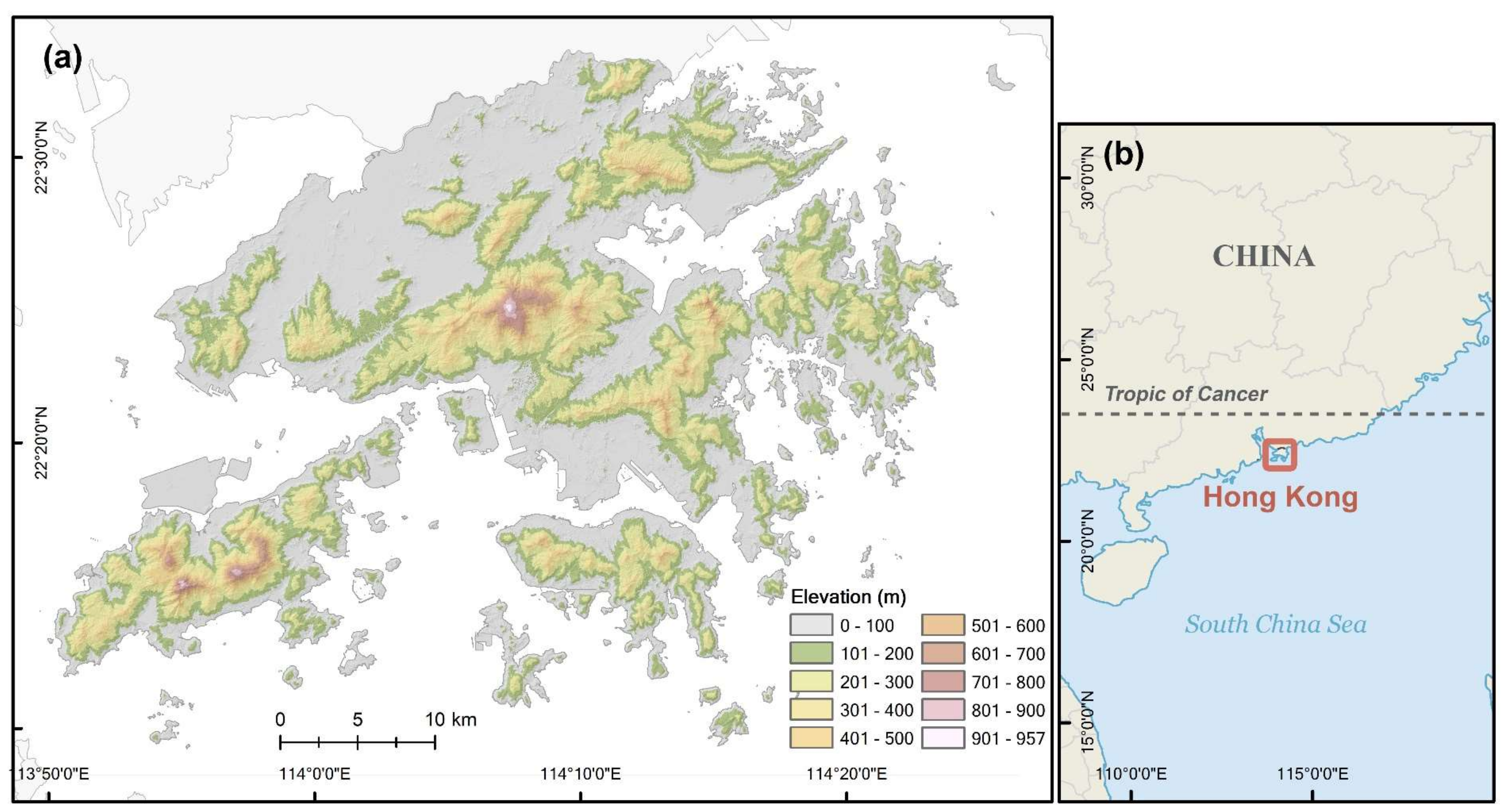
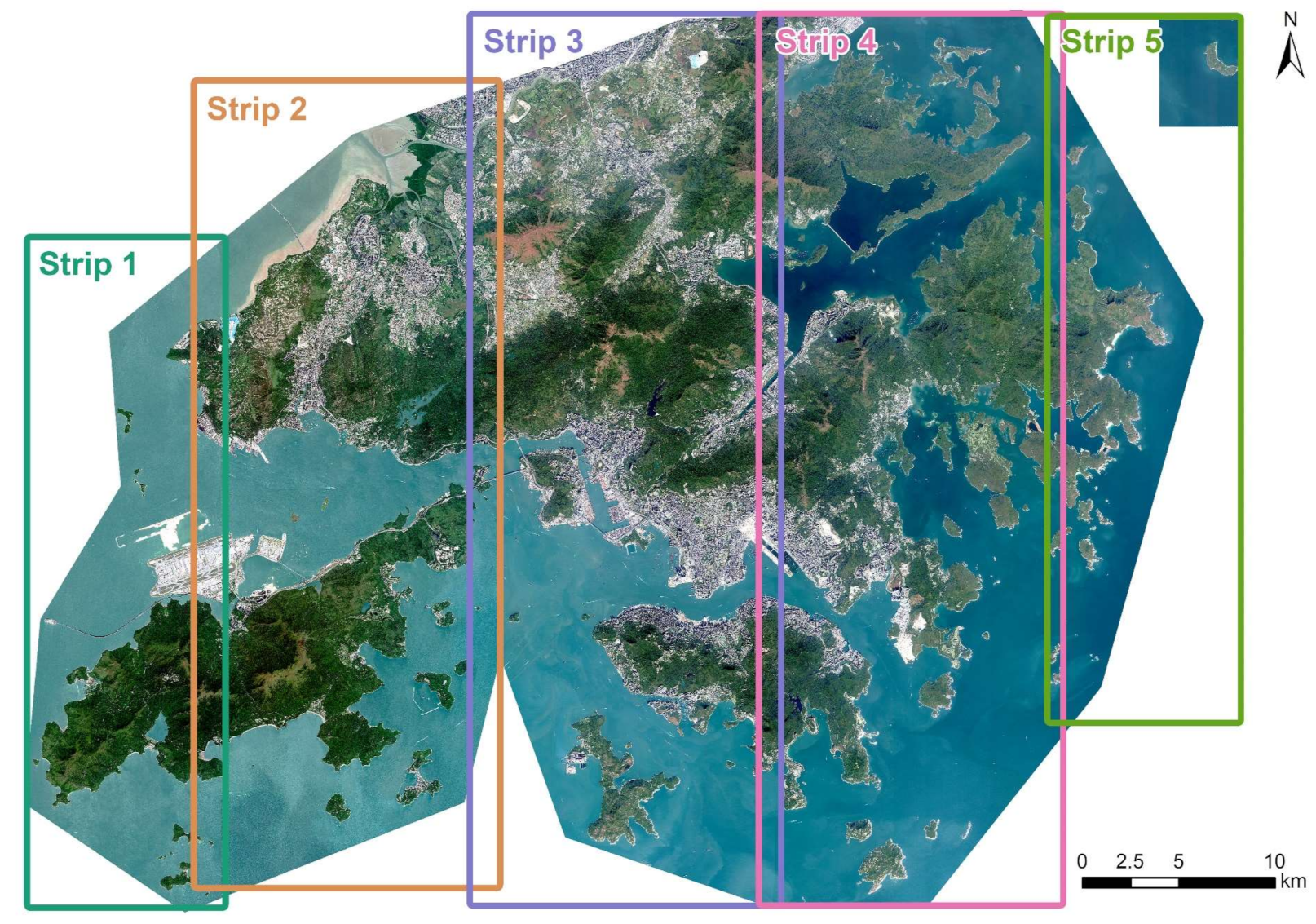
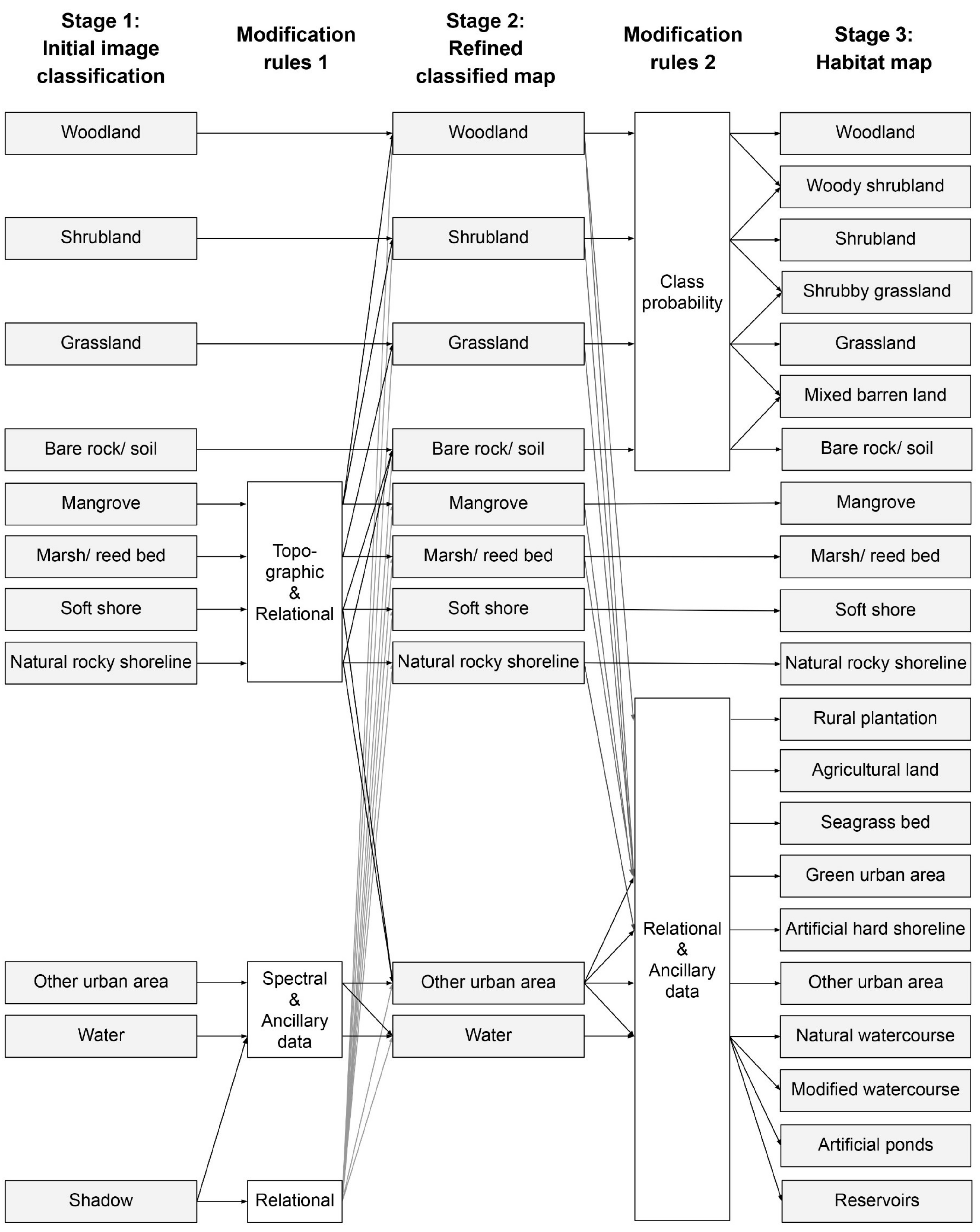
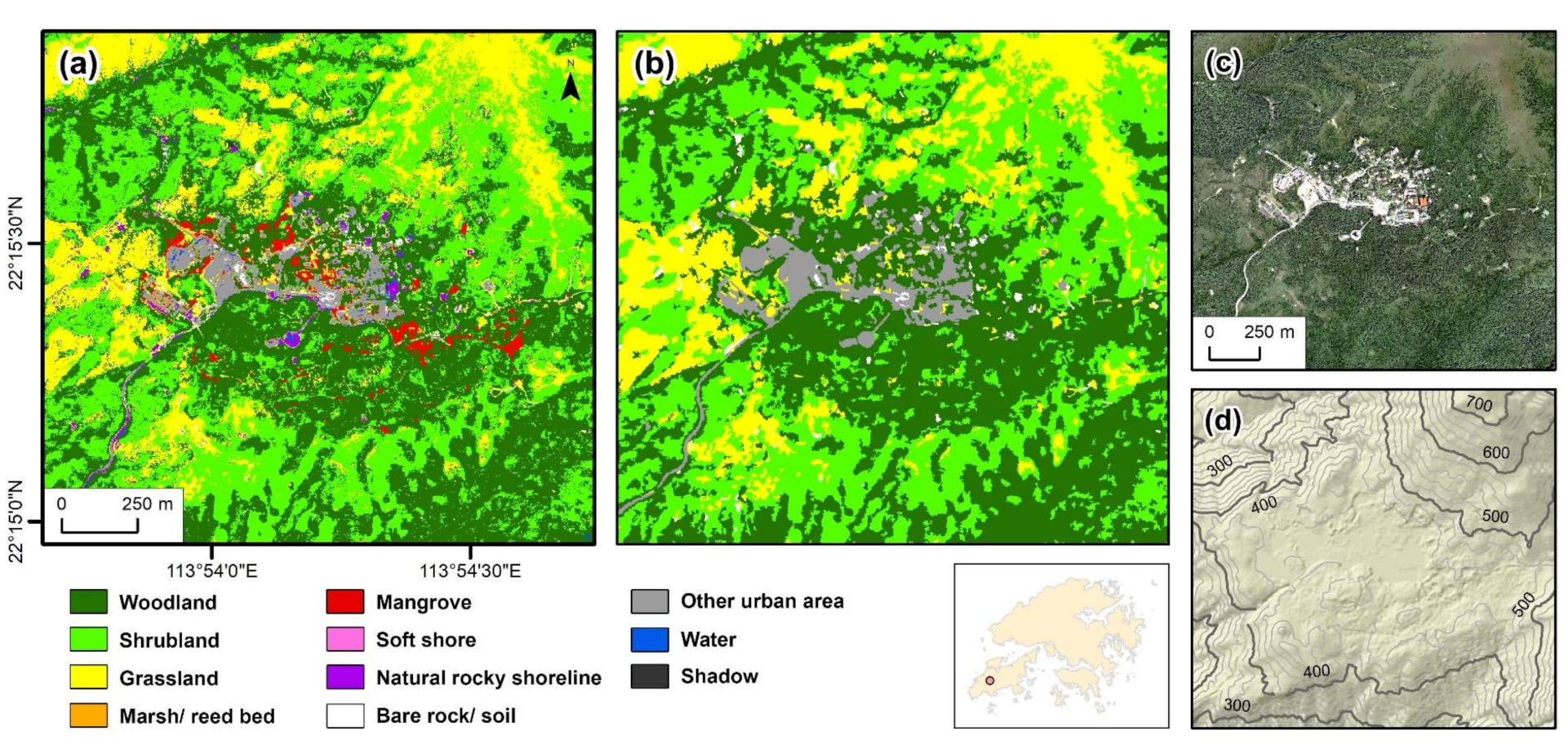

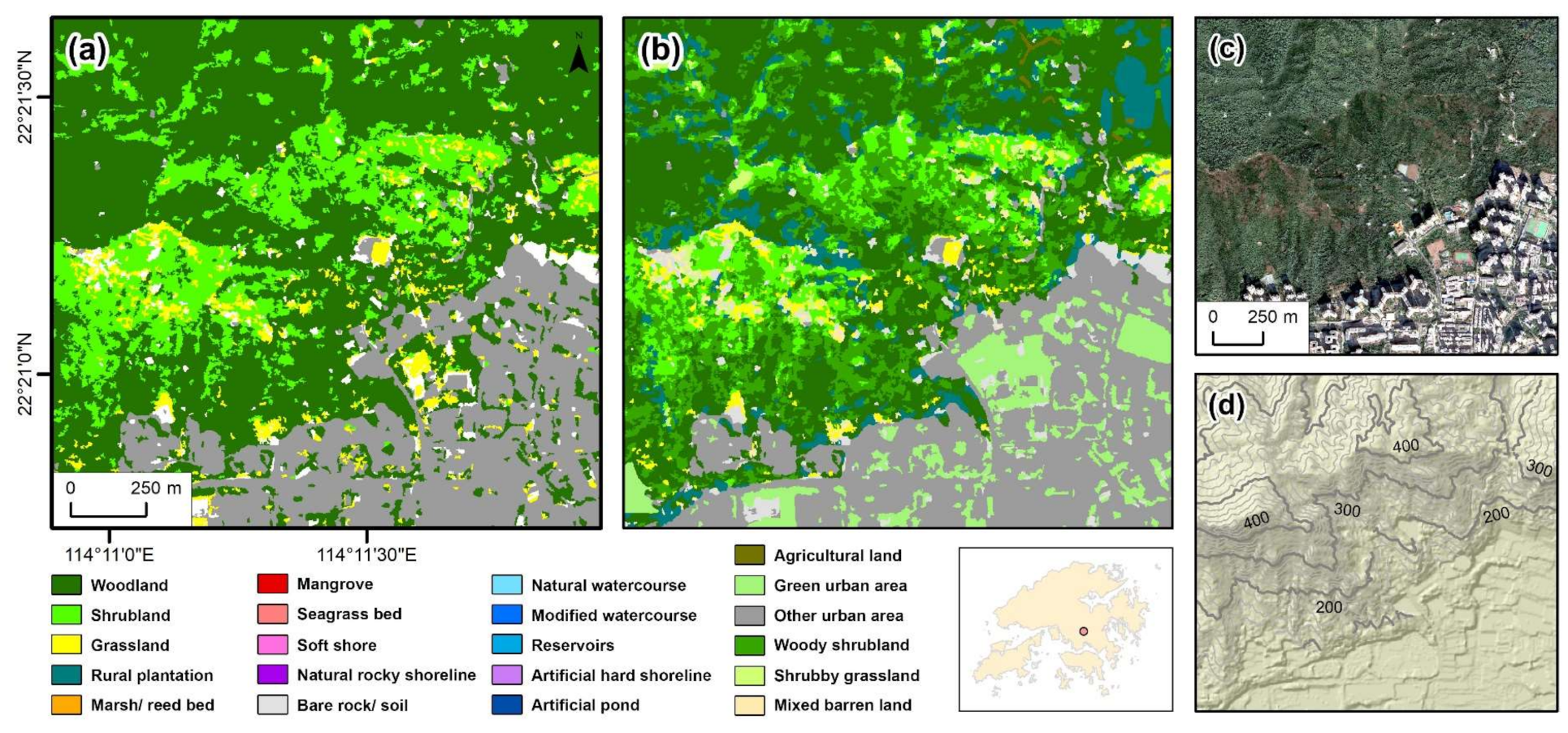

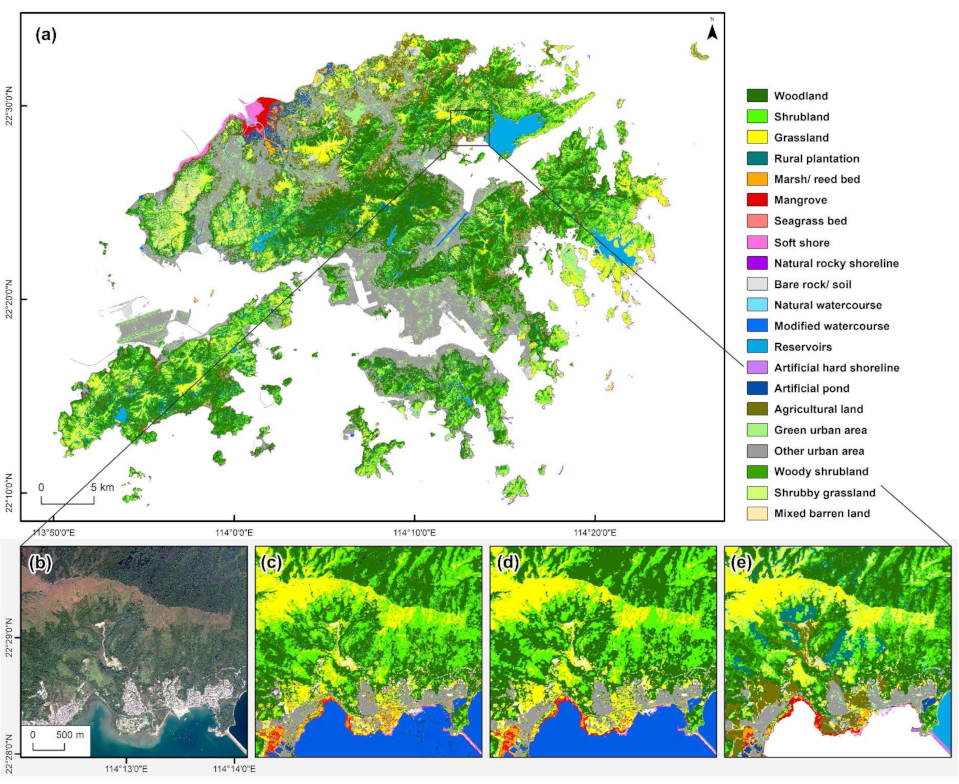

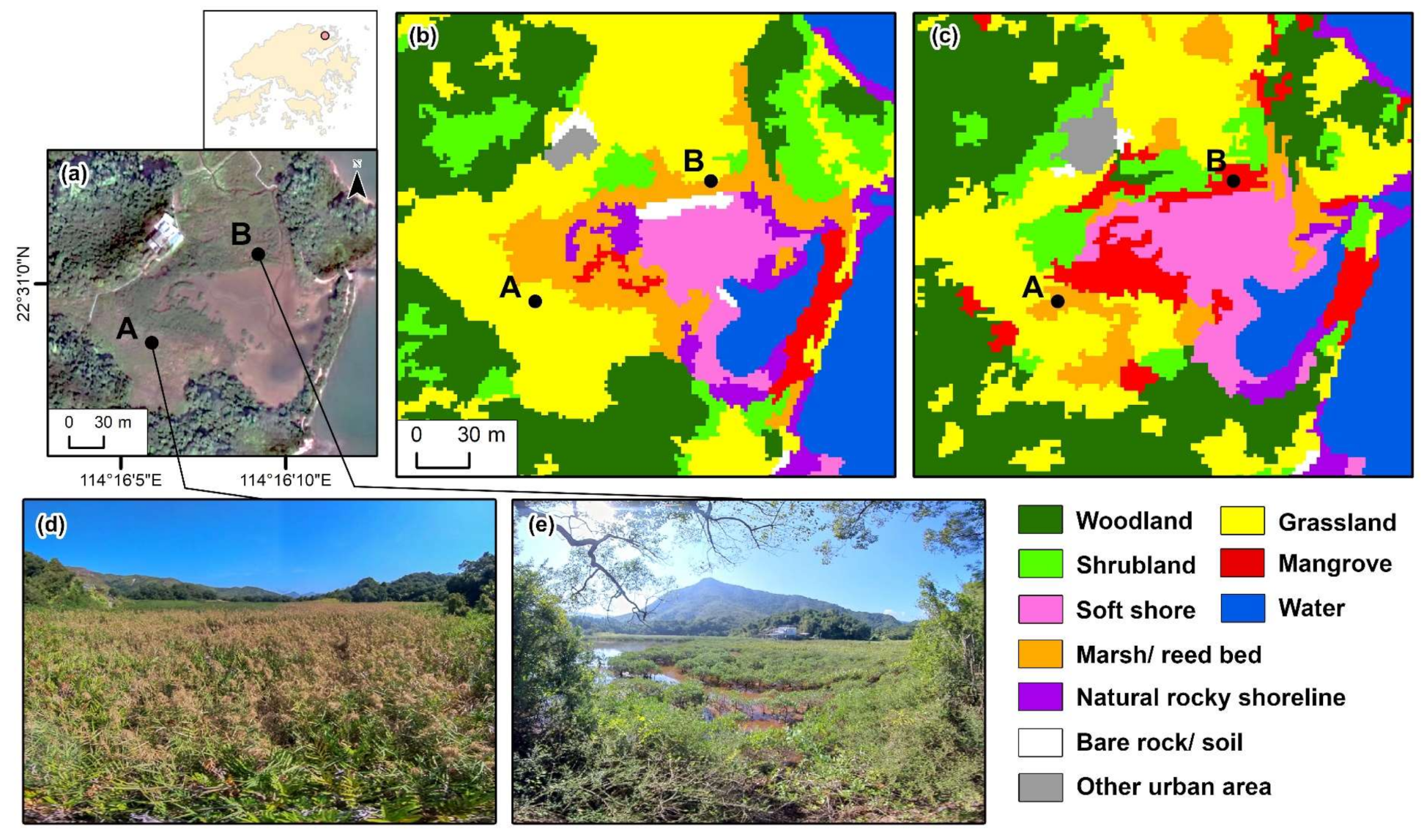

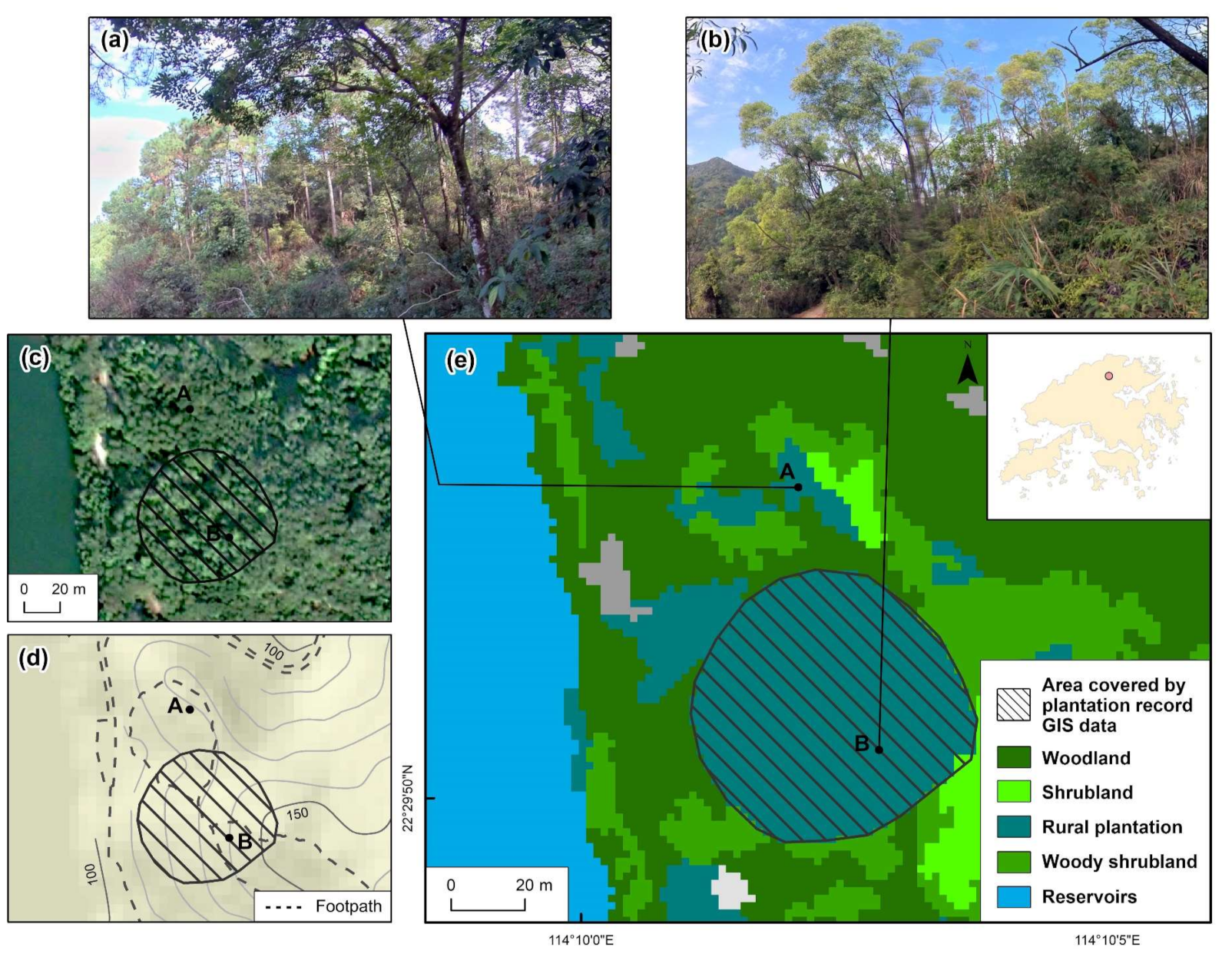
| Strip | Satellite | ID | Date | Off Nadir (°) | Target Azimuth (°) | Coverage Area (km2) |
|---|---|---|---|---|---|---|
| 1 | WV-3 | 10400100528D3800 | 22 September 2019 | 23.0 | 128.4 | 236 |
| 2 | WV-3 | 1040010052065F00 | 22 September 2019 | 24.3 | 114.0 | 547 |
| 3 | WV-2 | 10300100A19B0600 | 14 December 2019 | 7.8 | 327.0 | 651 |
| 4 | WV-2 | 103001009D694A00 | 14 December 2019 | 12.6 | 353.8 | 697 |
| 5 | WV-2 | 103001009C0BA500 | 14 December 2019 | 17.3 | 2.2 | 180 |
| Layer | Source | Reference Date |
|---|---|---|
| Digital elevation model (DEM) | Airborne LiDAR survey (Civil Engineering and Development Department of Hong Kong Government) [53] | 1 December 2010– 8 January 2011 |
| Coastline | iB5000 digital topographic map (Survey and Mapping Office, Lands Department of Hong Kong Government) [54] | 23 January 2019 |
| Cultivated land | ||
| Urban park | ||
| Pond | ||
| Reservoir | ||
| Tree planting record | Agriculture, Fisheries and Conservation Department of Hong Kong Government | 30 April 2019 |
| Seagrass | ||
| Building shadow | In-house computation from building height and solar angle at image acquisition time | 23 January 2019 |
| Artificial hard shoreline | Manual digitization from satellite image | 22 September 2019–14 December 2019 |
| Habitat | Definition |
|---|---|
| Woodland | Rural lands mainly covered by tree species. |
| Shrubland | Rural lands mainly covered by shrub species. |
| Grassland | Rural lands mainly covered by grass species. |
| Rural plantation | Rural lands mainly covered by woody plants and the top canopy is dominated by manually planted species in an organized and systematic way. |
| Marsh/reed bed | Lands, including abandoned agricultural land, covered with shallow waters and dominated by hydrophytes seasonally or all year round. |
| Mangrove | Coastal lands covered by true mangrove plant species. |
| Seagrass bed | Coastal lands covered by seagrass species. |
| Soft shore | Coastal lands of fine-grained sediment (i.e. sand, silt or finer particles) between high and low tide marks. |
| Natural rocky shoreline | Coastal lands of rocks between high and low tide marks. |
| Bare rock/soil | Natural open rock faces or disturbed lands, or "badlands" denuded of vegetation. |
| Natural watercourse | Rivers and streams experiencing natural flow patterns in unchanneled watercourse beds and banks. |
| Modified watercourse | Channelized rivers and streams, which are often without natural banks and beds, and are not subject to natural flow patterns (e.g., drainage channels and nullahs). |
| Reservoirs | Artificial lake used as a source of water supply. |
| Artificial hard shoreline | Man-made intertidal hard shore habitats (e.g., seawalls, jetties, groins and piers). |
| Artificial ponds | Small artificial water bodies constructed for the aquaculture purpose (e.g., gei wai and fishponds). |
| Agricultural land | Lands currently under cultivation, and lands not currently under land cultivation and yet to transform into other habitats such as marsh/reed bed. |
| Green urban area | Urban lands undergone artificial greening for various purposes (e.g., golf area courses, urban parks, and vegetation on the roadside). |
| Other urban area | Lands occupied by urban, other highly modified habitats (e.g., quarry, landfill) or industrial storage/containers. |
| Woody shrubland | Rural lands covered by a mixture of wood and shrub species and each of them occupies at least 1/3 of the coverage. |
| Shrubby grassland | Rural lands covered by a mixture of shrub and grass species and each of them occupies at least 1/3 of the coverage. |
| Mixed barren land | Rural lands covered by a mixture of grass and bare rock/ soil and each of them occupies at least 1/3 of the coverage. |
| Variable | Equation | Reference |
|---|---|---|
| Normalized Difference Vegetation Index (NDVI) | [61] | |
| Enhanced Vegetation Index (EVI) | [62] | |
| Green Normalized Difference Vegetation Index (GNDVI) | [63] | |
| Red Edge Normalized Difference Vegetation Index (RENDVI) | [63] | |
| Modified Chlorophyll Absorption in Reflectance Index (MCARI) | [64] |
| Classification | Type | Description | Number of Variables |
|---|---|---|---|
| Pixel-based classification | Spectral bands | WorldView-2/3 bands (Coastal blue, Blue, Green, Yellow, Red, Red-edge, Near-infrared [NIR]-1, NIR-2) | 8 |
| Spectral indices | NDVI, EVI, GNDVI, RENDVI, MCARI | 5 | |
| Textures | Grey level co-occurrence matrix (GLCM) features | 10 | |
| Terrain | Slope, Aspect | 2 | |
| Total: 25 | |||
| Object-based classification | Spectral band statistics | Means and standard deviations of eight bands at 20 segmentation scale | 16 |
| Means and standard deviations of eight bands at 80 segmentation scale | 16 | ||
| Spectral indices | Means and standard deviations of five spectral indices | 10 | |
| Terrain | Slope, Aspect | 2 | |
| Geometry | Area, Compactness, Rectangularity | 3 | |
| Total: 47 |
| Rule | From Class | Type | Criteria | To Class | Objective |
|---|---|---|---|---|---|
| 1 | Natural rocky shoreline OR Soft shore | Topographic, relational | Distance from coastline > 50 m OR Terrain height > 5 m | Bare rock/ soil OR Other urban area | Merge rocky/ soft shore regions located in highland to adjacent bare or urban area |
| 2 | Mangrove | Topographic, relational | Distance from coastline > 2000 m OR Terrain height > 5 m | Woodland OR Shrubland | Merge mangrove regions located in highland to adjacent woodland or shrubland |
| 3 | Marsh/ reed bed | Topographic | Terrain height > 5 m | Grassland | Rectify marsh/ reed bed regions located in highland to grassland |
| 4 | Water | Spectral, ancillary data | GNDVI > 0.3 OR Intersect with building shadow layer | Shadow | Rectify water pixels to shadow based on spectral index |
| 5 | Other urban area OR Shadow | Ancillary data | Not located inside coastline layer | Water | Rectify pixels outside land area to water |
| 6 | Shadow | Relational | All | Class of the nearest neighbour | Rectify shadow pixels (including those generated in Rule 4) to nearby classes |
| 7 | All | Relational | Area < 100 m2 (25 pixels) | Class of the nearest neighbour | Eliminate regions with areas smaller than minimum mapping unit (MMU) |
| Rule | From Class | Criteria | To Class | Objective |
|---|---|---|---|---|
| 1 | Woodland OR Shrubland | 0.3 ≤ P(Woodland) ≤ 0.65 AND 0.3 ≤ P(Shrubland) ≤ 0.65 | Woody shrubland | Create mixed habitats by combining class membership probabilities |
| 2 | Shrubland OR Grassland | 0.3 ≤ P(Shrubland) ≤ 0.8 AND 0.2 ≤ P(Grassland) ≤ 0.7 AND P(Shrubland) + P(Grassland) ≥ 0.6 | Shrubby grassland | |
| 3 | Grassland OR Bare rock/ soil | 0.1 ≤ P(Grassland) ≤ 0.8 AND 0.05 ≤ P(Bare rock/ soil) ≤ 0.7 AND P(Grassland) + P(Bare rock/ soil) ≥ 0.4 | Mixed barren land | |
| 4 | Woodland | Random forest classification based on field survey data | Rural plantation | Discriminate rural plantation from woodland |
| 5 | Woodland OR Woody shrubland | Intersect with tree planting record layer | Rural plantation | Create habitats based on ancillary layers |
| 6 | Vegetation-related | Intersect with urban park layer | Green urban area | |
| 7 | Vegetation-related | Surrounded by other urban area | Green urban area | Create habitats based on relational rules |
| 8 | Vegetation-related | Intersect with cultivated land layer | Agricultural land | Create habitats based on ancillary layers |
| 9 | All | Intersect with seagrass layer | Seagrass bed | |
| 10 | Other urban area OR Natural rocky shoreline | Intersect with artificial hard shoreline layer | Artificial hard shoreline | |
| 11 | Water | Intersect with pond layer | Artificial ponds | |
| 12 | Water | Intersect with reservoir layer | Reservoirs | |
| 13 | Water | Surrounded by other urban area | Modified watercourse | Create habitats based on relational rules |
| 14 | Water | Not satisfying Rule 11–13 | Natural watercourse | Modify remaining water pixels |
| 15 | Water | Located outside the coastline layer | No data | Remove sea area |
| Classification Accuracy | Pixel-based SVM | Pixel-based RF | Object-based SVM | Object-based RF |
|---|---|---|---|---|
| OA | 76.0% (±3.9%) | 84.0% (±3.1%) | 77.1% (±4.2%) | 76.6% (±4.1%) |
| Kappa | 0.73 | 0.82 | 0.75 | 0.74 |
| OA (before rules) | 67.7% (±3.6%) | 73.1% (±3.5%) | 69.0% (±4.8%) | 68.6% (±4.6%) |
Publisher’s Note: MDPI stays neutral with regard to jurisdictional claims in published maps and institutional affiliations. |
© 2021 by the authors. Licensee MDPI, Basel, Switzerland. This article is an open access article distributed under the terms and conditions of the Creative Commons Attribution (CC BY) license (https://creativecommons.org/licenses/by/4.0/).
Share and Cite
Kwong, I.H.Y.; Wong, F.K.K.; Fung, T.; Liu, E.K.Y.; Lee, R.H.; Ng, T.P.T. A Multi-Stage Approach Combining Very High-Resolution Satellite Image, GIS Database and Post-Classification Modification Rules for Habitat Mapping in Hong Kong. Remote Sens. 2022, 14, 67. https://doi.org/10.3390/rs14010067
Kwong IHY, Wong FKK, Fung T, Liu EKY, Lee RH, Ng TPT. A Multi-Stage Approach Combining Very High-Resolution Satellite Image, GIS Database and Post-Classification Modification Rules for Habitat Mapping in Hong Kong. Remote Sensing. 2022; 14(1):67. https://doi.org/10.3390/rs14010067
Chicago/Turabian StyleKwong, Ivan H. Y., Frankie K. K. Wong, Tung Fung, Eric K. Y. Liu, Roger H. Lee, and Terence P. T. Ng. 2022. "A Multi-Stage Approach Combining Very High-Resolution Satellite Image, GIS Database and Post-Classification Modification Rules for Habitat Mapping in Hong Kong" Remote Sensing 14, no. 1: 67. https://doi.org/10.3390/rs14010067
APA StyleKwong, I. H. Y., Wong, F. K. K., Fung, T., Liu, E. K. Y., Lee, R. H., & Ng, T. P. T. (2022). A Multi-Stage Approach Combining Very High-Resolution Satellite Image, GIS Database and Post-Classification Modification Rules for Habitat Mapping in Hong Kong. Remote Sensing, 14(1), 67. https://doi.org/10.3390/rs14010067






